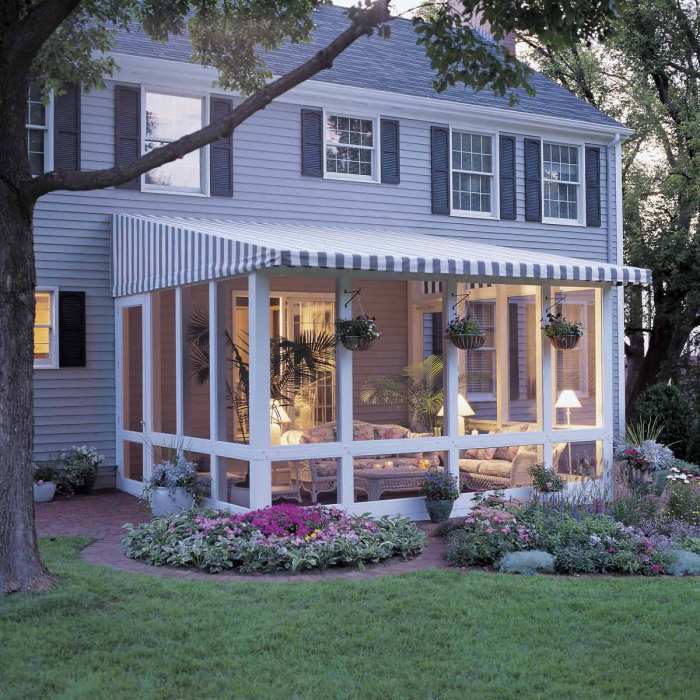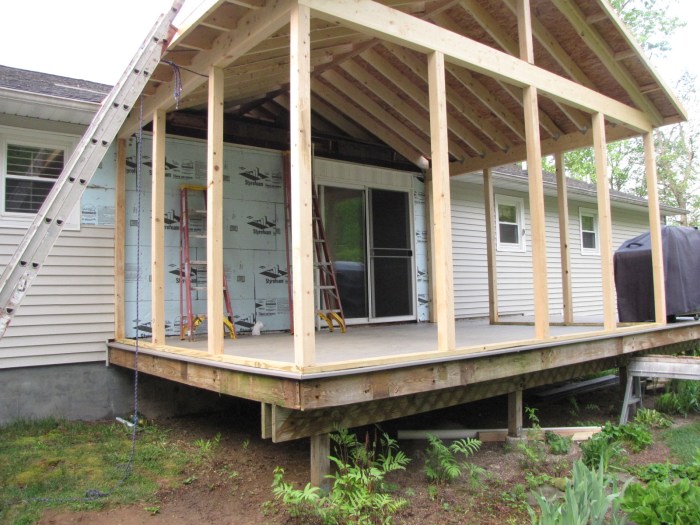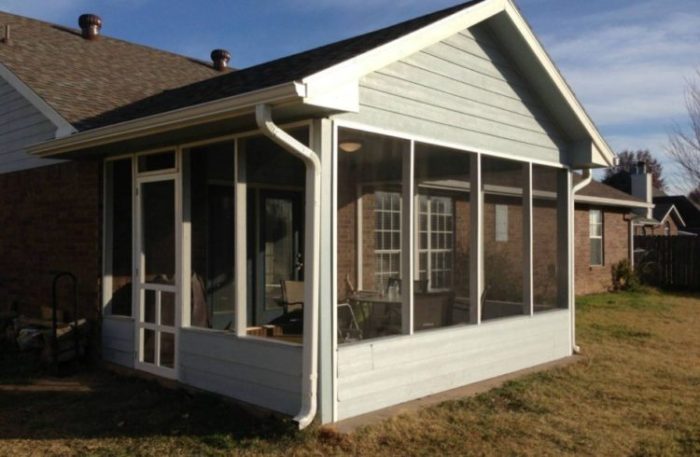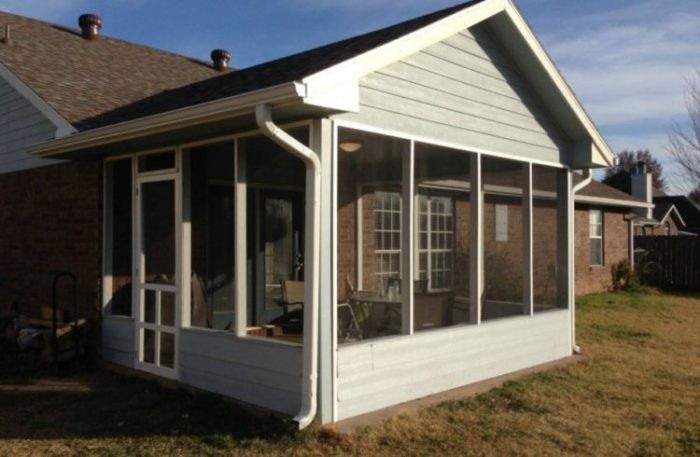DIY porch screen takes center stage, inviting you to transform your outdoor space into a relaxing haven. This comprehensive guide empowers you to craft a custom screened porch that seamlessly blends style and functionality, adding value and enjoyment to your home.
From planning and design to construction and finishing touches, we’ll explore the essential steps involved in building your own porch screen. We’ll delve into the advantages and disadvantages of various screen materials, discuss the importance of choosing the right frame, and guide you through the process of installing screen material, doors, and windows. We’ll also address safety considerations, cost estimates, and provide tips for troubleshooting and maintenance.
Introduction to DIY Porch Screens
A screened porch offers a wonderful way to extend your living space outdoors while enjoying the fresh air and natural beauty. It provides protection from pesky insects and the elements, creating a comfortable and inviting retreat. Building your own screened porch can be a rewarding DIY project, allowing you to customize it to your specific needs and style.
This guide will introduce you to the world of DIY porch screens, covering the basics of materials, screen types, and design considerations. We’ll explore the advantages and disadvantages of various options, helping you make informed decisions for your project.
Materials for Porch Screens
The materials used for porch screens are crucial for both aesthetics and functionality. Common choices include wood, aluminum, and vinyl.
- Wood: Offers a classic, natural look and can be stained or painted to match your home’s exterior. However, wood requires regular maintenance to prevent rot and insect damage.
- Aluminum: Lightweight, durable, and resistant to rust and corrosion. It’s often available in various colors and finishes.
- Vinyl: Low-maintenance, weather-resistant, and available in a wide range of styles. However, vinyl can be more expensive than other options.
Screen Types
The type of screen you choose significantly impacts the look, functionality, and longevity of your porch. Common options include fiberglass, aluminum, and mesh.
- Fiberglass: A popular choice for its affordability and durability. It’s lightweight, easy to install, and offers good visibility. However, fiberglass screens can be susceptible to tearing and may not provide as much insect protection as other options.
- Aluminum: Durable, rust-resistant, and offers excellent insect protection. Aluminum screens are typically more expensive than fiberglass but can withstand harsh weather conditions.
- Mesh: A newer option known for its fine mesh that provides superior insect protection, including against smaller pests like mosquitos. Mesh screens can be made from various materials, including fiberglass and stainless steel, and are often used in areas with high insect activity.
Planning and Design

Before you start building your porch screen, you’ll need to plan out the project. This includes considering the size and style of your porch, as well as your budget.
Porch Size and Style
It’s important to measure your porch carefully to determine the size of the screen frame you’ll need. You’ll also want to consider the style of your porch and choose a screen that complements it. For example, a traditional porch might look best with a simple screen frame, while a modern porch might look better with a more contemporary design.
Budget
You should set a budget for your project before you start shopping for materials. This will help you narrow down your choices and avoid overspending. Consider the cost of the screen material, the frame material, and any additional hardware you’ll need.
Screen Material
There are many different types of screen materials available, so it’s important to choose one that’s right for your needs. Here are a few factors to consider:
- Durability: Choose a screen material that’s strong and durable enough to withstand the elements.
- Visibility: Consider how much visibility you want. Some screen materials are more opaque than others.
- Maintenance: Choose a screen material that’s easy to clean and maintain.
Frame Material
The frame material you choose will affect the look and durability of your screen. Here are a few popular options:
- Wood: Wood is a classic choice for porch screens. It’s relatively inexpensive and easy to work with.
- Aluminum: Aluminum is a durable and weather-resistant option. It’s also available in a variety of colors.
- Vinyl: Vinyl is a low-maintenance option that’s resistant to rot and insects.
Measuring and Planning
Once you’ve chosen your materials, it’s time to start measuring and planning the screen frame dimensions.
Measure twice, cut once!
- Measure the width and height of your porch opening. Make sure to account for any trim or molding that’s already in place.
- Decide on the size and shape of your screen frame. You can create a simple rectangular frame or get more creative with a curved or angled design.
- Draw a sketch of your screen frame. This will help you visualize the final product and ensure that all the pieces fit together properly.
Adding Doors and Windows

Adding doors and windows to your porch screen can enhance its functionality and aesthetics. Doors provide convenient access, while windows allow for natural light and ventilation. When incorporating doors and windows, consider the overall design and functionality of your porch.
Types of Doors and Windows
There are several types of doors and windows that can be incorporated into a porch screen, each offering unique advantages.
- Screen Doors: These doors are typically made of a lightweight aluminum or fiberglass frame with a mesh screen insert. They provide excellent ventilation and insect protection while maintaining an open feel.
- French Doors: French doors are stylish and elegant, featuring two or more panels that swing inward or outward. They can be made of wood, fiberglass, or aluminum, and can be fitted with glass panels for added light and visibility.
- Sliding Doors: Sliding doors are space-saving and convenient, as they slide horizontally along a track. They can be made of various materials, including aluminum, vinyl, and wood.
- Screen Windows: Similar to screen doors, screen windows are made of a lightweight frame with a mesh screen insert. They provide ventilation and insect protection while allowing for natural light to enter.
- Glass Windows: Glass windows offer excellent visibility and natural light. They can be made of various types of glass, including tempered glass for added safety.
Building and Installing Screen Doors and Windows
Building and installing screen doors and windows can be a DIY project, but it requires some basic carpentry skills and tools.
- Measure and Cut: Accurately measure the opening where you want to install the door or window. Cut the frame material to size using a miter saw or table saw.
- Assemble the Frame: Join the frame pieces together using wood glue and screws. Make sure the corners are square and the frame is level.
- Install the Screen: For screen doors and windows, install the screen mesh into the frame using a staple gun or screen clips.
- Install the Door or Window: Attach the door or window frame to the porch screen using hinges, latches, and screws.
Tips for Ensuring Proper Fit and Function
To ensure your doors and windows function properly and fit seamlessly, consider these tips:
- Check for Level: Use a level to ensure that the frame is level before attaching it to the porch screen.
- Allow for Clearance: Leave enough clearance between the door or window and the porch screen to allow for smooth opening and closing.
- Use Weatherstripping: Install weatherstripping around the door or window to prevent drafts and leaks.
- Test Functionality: Open and close the door or window several times to ensure it functions smoothly.
Cost and Time Estimates

Building a DIY porch screen can be a rewarding project, but it’s essential to consider the associated costs and the time required to complete it. This section will Artikel the estimated costs and provide a realistic timeline, considering factors that might influence the overall project.
Estimated Costs
The cost of building a porch screen will vary depending on the size of your porch, the materials you choose, and the complexity of the design. Here’s a breakdown of the estimated costs for materials and labor:
- Materials:
- Framing lumber: $100 – $300, depending on the size of the screen and the type of wood used.
- Screen material: $50 – $150, depending on the type of screen fabric and the size of the screen.
- Hardware: $50 – $100, including staples, screws, brackets, and hinges.
- Doors and windows: $100 – $500, depending on the size and style of the doors and windows.
- Paint or stain: $25 – $75, depending on the size of the screen and the type of paint or stain used.
- Labor:
- If you are doing the work yourself, the labor cost will be minimal, but you should factor in the time you spend on the project.
- If you are hiring a contractor, the labor cost will vary depending on the size and complexity of the project, but you can expect to pay between $500 and $2,000 for labor.
Estimated Timeline, Diy porch screen
The time it takes to build a DIY porch screen will depend on the size and complexity of the project, as well as your experience with construction. Here’s a realistic timeline for completing the project:
- Planning and design: 1-2 days
- Purchasing materials: 1 day
- Building the frame: 2-3 days
- Installing the screen material: 1-2 days
- Adding doors and windows: 2-3 days
- Painting or staining: 1-2 days
Factors Influencing Costs and Duration
Several factors can influence the cost and duration of your DIY porch screen project:
- Size of the screen: A larger screen will require more materials and labor, increasing the cost and duration of the project.
- Complexity of the design: A more complex design with multiple doors, windows, or intricate details will require more time and effort, increasing the cost and duration of the project.
- Materials chosen: The type of wood, screen fabric, and hardware you choose will affect the overall cost of the project. For example, using premium wood or high-quality screen fabric will be more expensive than using standard materials.
- Labor costs: If you are hiring a contractor, the labor costs will vary depending on the contractor’s rates and the complexity of the project.
- Availability of materials: If you are building the screen during a busy season or if you need specialized materials, you may have to wait longer for materials to be delivered, which can delay the project.
DIY Porch Screen Projects
A porch screen can enhance your outdoor living space by providing shade, privacy, and protection from insects. There are many DIY porch screen projects that you can tackle, ranging from simple to complex. These projects can be customized to fit your needs and style, adding a unique touch to your home.
DIY Porch Screen Project Examples
Here are some DIY porch screen project examples, each with its own unique design and construction method:
| Project | Description | Resources | Image |
|---|---|---|---|
| Simple Framed Screen | A basic framed screen constructed with wood and screening material. | Family Handyman | A simple framed screen can be made with 2×4 lumber for the frame and mosquito netting or vinyl screening for the material. The frame is assembled using wood screws or nails, and the screening material is attached using staples or a staple gun. This project requires basic woodworking skills and tools, and can be completed in a few hours. |
| Retractable Screen | A screen that can be rolled up or down for easy access. | Home Depot | A retractable screen uses a mechanism that allows the screen to be rolled up and down. This mechanism is usually mounted to a wall or ceiling, and the screen is attached to the mechanism using a track or rail. The screen material is typically a lightweight fabric or mesh. This project requires more advanced woodworking skills and tools, and may take several hours to complete. |
| Custom-Shaped Screen | A screen with a unique shape, such as a curved or angled design. | Instructables | A custom-shaped screen can be made with a variety of materials, including wood, metal, and even PVC pipe. The shape is determined by the design and the desired effect. This project requires more advanced woodworking skills and tools, and may take several days to complete. |
| DIY Screen Door | A screen door that can be added to an existing porch or patio. | This Old House | A DIY screen door can be made with a variety of materials, including wood, metal, and even fiberglass. The door is typically hinged to the existing porch or patio frame, and is secured with a latch or handle. This project requires basic woodworking skills and tools, and can be completed in a few hours. |
Building a DIY porch screen is a rewarding project that allows you to create a personalized outdoor space that perfectly complements your home and lifestyle. With careful planning, attention to detail, and a bit of elbow grease, you can enjoy the benefits of a screened porch for years to come.
A DIY porch screen can be a great way to create a private and inviting outdoor space. You can enhance the ambiance by adding comfortable seating, and there are plenty of resources available for patio chairs DIY projects. Once your screen and chairs are in place, you’ll be ready to enjoy your porch in style.

